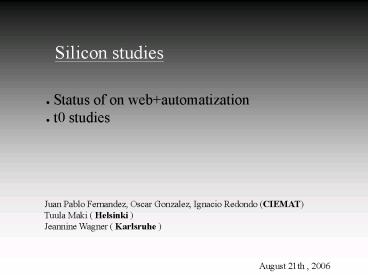Silicon studies - PowerPoint PPT Presentation
1 / 7
Title:
Silicon studies
Description:
Silicon studies. Juan Pablo Fernandez, Oscar Gonzalez, Ignacio Redondo (CIEMAT) ... Track selection: To calculate position of 'expected hit' tracks are selected ... – PowerPoint PPT presentation
Number of Views:25
Avg rating:3.0/5.0
Title: Silicon studies
1
Silicon studies
- Status of on webautomatization
- t0 studies
Juan Pablo Fernandez, Oscar Gonzalez,
Ignacio Redondo (CIEMAT) Tuula Maki (
Helsinki ) Jeannine Wagner ( Karlsruhe )
August 21th , 2006
2
Data sample and selection
- Track selection To calculate position of
expected hit tracks are selected with the
following criteria - pt gt 1. GeV with 4 first segments in COT
(relaxed) - Delta z lt 1 cm (w.r.t. primary (Z-)vertex)
- Delta d0 lt 100 microns (w.r.t. primary
vertex) - Looking at nearest hit to the track
- If expecting N hits in a track, at least N-1
must have been found - Cluster selection
- Select hit closest to the expected hit
(track intersection to wafer) - Hit is obtained from official reconstruction
- Hit does not contain bad strips
- Reject hit if second hit closer than 1 mm
(local units) - No requirement to have clusters in both sides
(relaxed) - Note that hits are likely to belong to the track
used to define the expected hit (i.e.
residuals are biased)
3
Web changes
You can now select a run range if you wish (if
no run range selected, you will just get the
whole range from the very beginning) You can
now type details in order to get charge, noise,
residual or occupancy distributions (for any
particular ladder and any particular run)
Cometics introduced some explanation of what is
what (and link to the web page where the
variables are introduced)
4
t0 studies
- obtained via the COT - divided t0 in 6 bins
- looked at charge distribution and get MPV on
each bin - plot MPV for all 6 bins - using a
single run to avoid effect of changes on t0 along
with time - perform the above for every
individual ladder (each plot shown)
t0 studies
Bulkhead 2
Bulkhead 1
Results for L1 (rphi clusters)
5
t0 studies (L1 z clusters)
Wedges from 0 to 11
bulkhead 2
bulkhead 1
6
t0 studies (L6 rphi clusters)
Wedges from 0 to 11
bulkhead 2
bulkhead 1
7
t0 studies (L6 z clusters)
Wedges from 0 to 11
bulkhead 1
bulkhead 2

